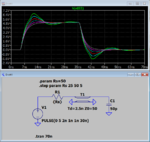venn_ng
Member level 5
Let's say there is a digital logic driving a capacitor Cload through a transmission line. If we have a really thick metal for the transmission line, such that wL>>R at the frequency of operation and the skin effect is minimal, then does it make sense to use this inductance to boost the rise-time at Cload. We can do this by choosing Rs slightly below the Zo of the Transmission line but not too below to cause ringing. In other words, we make use of reflection to boost the rise time. This can help in reducing power in the driver and pre-driver.
Is there a flaw in the above argument or any possible issue? Let me know if the question is not clear.
The argument follows from the analysis shown in this link
Is there a flaw in the above argument or any possible issue? Let me know if the question is not clear.
The argument follows from the analysis shown in this link
Resonance in Short Transmission Line
The resonant frequency and Q of a short, unterminated line varies strongly with capacitive loading. Newsletter v6-06 4/14/2003(by Howard Johnson)
www.sigcon.com
Last edited:

